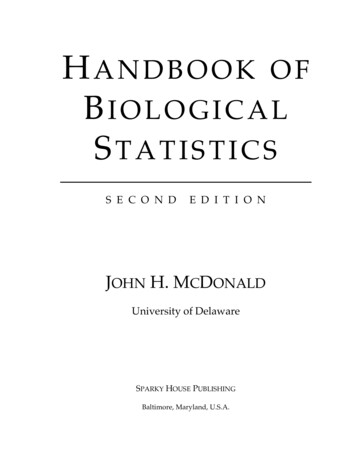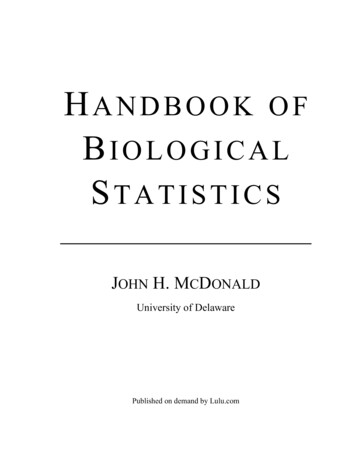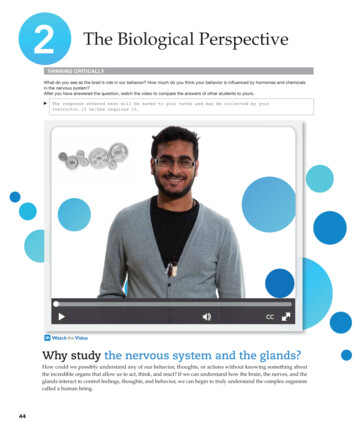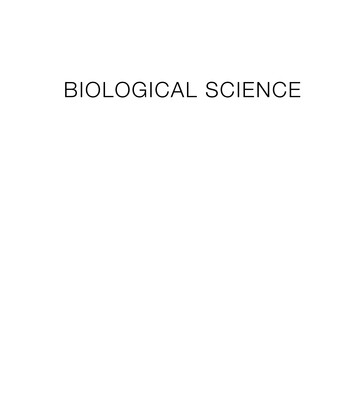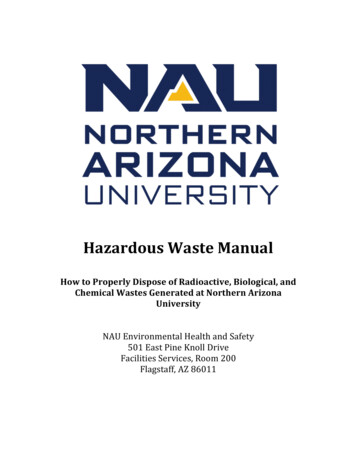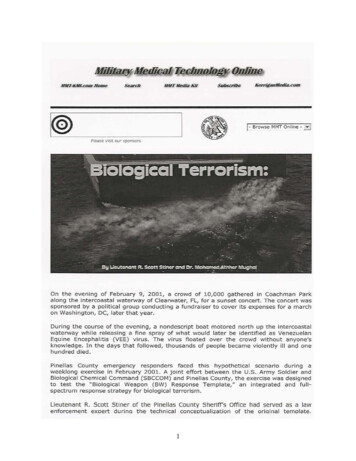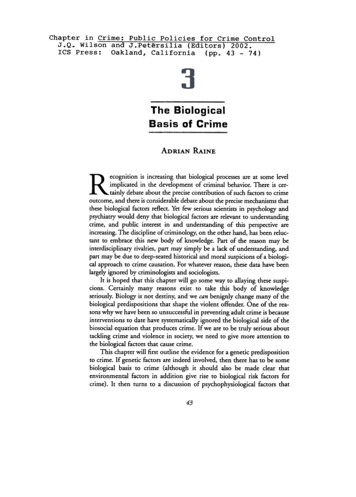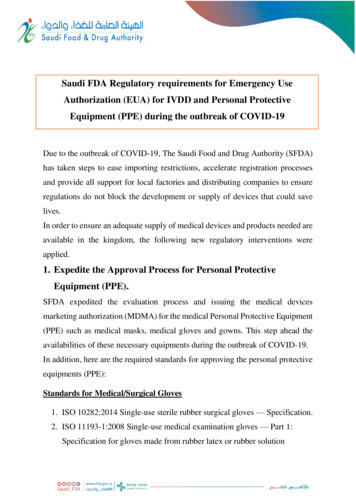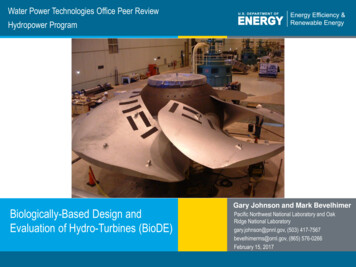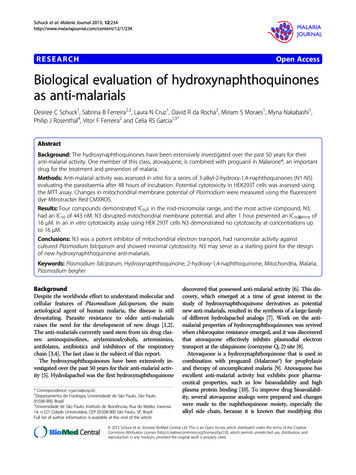
Transcription
Schuck et al. Malaria Journal 2013, 34RESEARCHOpen AccessBiological evaluation of hydroxynaphthoquinonesas anti-malarialsDesiree C Schuck1, Sabrina B Ferreira2,3, Laura N Cruz1, David R da Rocha2, Miriam S Moraes1, Myna Nakabashi1,Philip J Rosenthal4, Vitor F Ferreira2 and Celia RS Garcia1,5*AbstractBackground: The hydroxynaphthoquinones have been extensively investigated over the past 50 years for theiranti-malarial activity. One member of this class, atovaquone, is combined with proguanil in Malarone , an importantdrug for the treatment and prevention of malaria.Methods: Anti-malarial activity was assessed in vitro for a series of 3-alkyl-2-hydroxy-1,4-naphthoquinones (N1-N5)evaluating the parasitaemia after 48 hours of incubation. Potential cytotoxicity in HEK293T cells was assessed usingthe MTT assay. Changes in mitochondrial membrane potential of Plasmodium were measured using the fluorescentdye Mitrotracker Red CMXROS.Results: Four compounds demonstrated IC50s in the mid-micromolar range, and the most active compound, N3,had an IC50 of 443 nM. N3 disrupted mitochondrial membrane potential, and after 1 hour presented an IC50ΔΨmit of16 μM. In an in vitro cytotoxicity assay using HEK 293T cells N3 demonstrated no cytotoxicity at concentrations upto 16 μM.Conclusions: N3 was a potent inhibitor of mitochondrial electron transport, had nanomolar activity againstcultured Plasmodium falciparum and showed minimal cytotoxicity. N3 may serve as a starting point for the designof new hydroxynaphthoquinone anti-malarials.Keywords: Plasmodium falciparum, Hydroxynaphthoquinone, 2-hydroxy-1,4-naphthoquinone, Mitochondria, Malaria,Plasmodium bergheiBackgroundDespite the worldwide effort to understand molecular andcellular features of Plasmodium falciparum, the mainaetiological agent of human malaria, the disease is stilldevastating. Parasite resistance to older anti-malarialsraises the need for the development of new drugs [1,2].The anti-malarials currently used stem from six drug classes: aminoquinolines, arylaminoalcohols, artemisinins,antifolates, antibiotics and inhibitors of the respiratorychain [3,4]. The last class is the subject of this report.The hydroxynaphthoquinones have been extensively investigated over the past 50 years for their anti-malarial activity [5]. Hydrolapachol was the first hydroxynaphthoquinone* Correspondence: cgarcia@usp.br1Departamento de Fisiologia, Universidade de São Paulo, São Paulo05508-900, Brazil5Universidade de São Paulo, Instituto de Biociências, Rua do Matão, travessa14, n.321 Cidade Universitária, CEP 05508-900 São Paulo, SP, BrazilFull list of author information is available at the end of the articlediscovered that possessed anti-malarial activity [6]. This discovery, which emerged at a time of great interest in thestudy of hydroxynaphthoquinone derivatives as potentialnew anti-malarials, resulted in the synthesis of a large familyof different hydrolapachol analogs [7]. Work on the antimalarial properties of hydroxynaphthoquinones was revivedwhen chloroquine resistance emerged, and it was discoveredthat atovaquone effectively inhibits plasmodial electrontransport at the ubiquinone (coenzyme Q, 2) site [8].Atovaquone is a hydroxynaphthoquinone that is used incombination with proguanil (Malarone ) for prophylaxisand therapy of uncomplicated malaria [9]. Atovaquone hasexcellent anti-malarial activity but exhibits poor pharmaceutical properties, such as low bioavailability and highplasma protein binding [10]. To improve drug bioavailability, several atovaquone analogs were prepared and changeswere made to the naphthoquinone moiety, especially thealkyl side chain, because it is known that modifying this 2013 Schuck et al.; licensee BioMed Central Ltd. This is an Open Access article distributed under the terms of the CreativeCommons Attribution License (http://creativecommons.org/licenses/by/2.0), which permits unrestricted use, distribution, andreproduction in any medium, provided the original work is properly cited.
Schuck et al. Malaria Journal 2013, 34chain can alter drug activity [7] and counteract drugresistance [11-13]. Recently, it was demonstrated that 2methyl-heptyl or 2-methyl-heptyl-trifluoromethyl 2-hydroxy1,4-naphthoquinones were highly effective against atovaquone-resistant P. falciparum [14].The aim of this work was to test the activity of a newseries of hydroxynaphthoquinones [15] against P. falciparum. One of these compounds, N3, had an IC50 againstcultured P. falciparum in the nM range, disrupted mitochondrial membrane potential, and had low toxicityagainst human cells suggesting potential as a lead compound for the development of new anti-malarial agents.Page 2 of 6Changes in mitochondrial membrane potential (ΨΔmit)Loss of parasite mitochondrial membrane potential(ΨΔmit) was determined using 5 μM Mitrotracker RedCMXROS as described previously [18]. Cultures wereincubated for 30 min at 37 C with the dye and thenfor 1 h with 10-fold serial dilutions (0.001-100 μM) ofN3 and atovaquone. As a control, 5 μM cyanide mchlorophenylhydrazone (CCCP), a protonophore thatdissipate the membrane potential, was used. Resultswere analysed by flow cytometry as described above.Cytotoxicity assays3D7 strain parasites were cultured and synchronized as described previously [16,17]. Briefly, parasites were routinelymaintained in A human erythrocytes (1-3% parasitaemiaand 2% haematocrit) in RPMI-1640 media supplementedwith 0.2% sodium bicarbonate, 50 mg/L hypoxanthine and10% type A human serum in 92% N2, 5% CO2 and 3% O2.The toxicity of hydroxynaphthoquinone derivatives toward HEK293T cells was evaluated with the 4,5dimethylthiazol- 2-yl-2,5- diphenyltetrazolium bromide(MTT) cell proliferation assay [19]. Cells (1.0 105/well)were seeded into 48 well plates and incubated in completemedium (Dulbecco’s Modified Eagle Media, GIBCO, LifeTechnologies; supplemented with 10% foetal bovineserum, 100 μg/ml streptomycin and 100 U/ml penicillin)for 24 h. Thereafter, medium was removed and replacedwith complete medium (450 μl/well); N3, atovaquone, andsolvent (for controls) were added (0.128, 0.64, 3.2, 16, 80and 400 μM) and cultures were incubated for 48 hours.Cells were then incubated with the MTT reagent for3 hours, and absorbance was evaluated.Cell culture of HEK293TStatistical analysesHEK293T (human embryonic kidney) cells were cultured in 75 cm2 vented tissue culture flasks at 37 C in ahumidified atmosphere containing 5% CO2 in Dulbecco’smodified essential medium (Gibco BRL) supplementedwith 10% (v/v) foetal bovine serum, 100 U/ml penicillin/and 100 μg/ml streptomycin.Analyses of parasitaemia were performed by a one-wayanalysis of variance test followed by post hoc analysisby the Dunnett’s Multiple Comparison Test usingGraphPad Prism software. IC50 values were producedusing sigmoid dose-response curves on GraphPad software. At least three independent experiments wereperformed for each assay.MethodsChemistryThe hydroxynaphthoquinones N1-5 were recently synthesized using a new methodology [15].In vitro culture of P. falciparumFlow cytometry analysisInfected erythrocytes at the ring stage were incubated withdifferent concentrations of the test compounds (N1-N50.005, 0.015, 0.045, 0.137, 0.411, 1.23, 3.70, 11.11, 33.33and 100 μM and atovaquone 0.005, 0.015, 0.045, 0.137,0.411, 1.23, 3.70, 11.11, 33.33 and 100 nM) for 48 hours;fixed in 2% paraformaldehyde in phosphate-buffered saline (PBS) for 24 hours; permeabilized with 0.1% TritonX-100 and 20 μg/ml RNase; incubated for 30 minutes at37 C; and stained with 1 nM Yoyo-1 (Molecular Probes).Parasitaemia was determined from dot plots (sidescatter versus fluorescence) of 5x104 cells acquired on aFACSCalibur flow cytometer using CELLQUEST software(Becton Dickinson). Initial gating was carried out with unstained, uninfected erythrocytes to account for erythrocyteautofluorescence and analysis performed using Flow Jo7.6.5 (TreeStar Inc).ResultsIn vitro activity of new hydroxynaphthoquinonesThe ability of compounds N1-N5 to disrupt the in vitrogrowth of P. falciparum was tested. The naphthoquinonesshowed activity against P. falciparum, with IC50s of 0.489 μM (Figure 1 and Additional file 1: Figure S1). OnlyN3 had an IC50 in the nM range (443 nM; Figure 2).Cytotoxicity effects on cells HEK293TCytotoxic activity against HEK293T cells was assessedwith a tetrazolium-based colorimetric assay. No significant cytotoxicity was observed at concentrations below16 μM. For N3, the concentration leading to 50% celldeath (CC50) was 54.6 0.23 μM (Figure 1). Foratovaquone the CC50 was 49 0.45 μM.
Schuck et al. Malaria Journal 2013, 34Page 3 of 6Figure 1 Biological activity of hydroxynaphtoquinones. Structure and biological activity of compounds N1-N5.Effect of N3 on ΔΨmitIt was also verified the effects of compound N3 on P.falciparum mitochondrial membrane potential (ΔΨmit).Compound N3 showed an IC50ΔΨmit 16 μM andatovaquone an IC50ΔΨmit 4.4 μM (Figure 3).Figure 2 Effect of new hydroxynaphthoquinones on P.falciparum growth. a) Structure of N3. b) Dose response curve forcompound N3 incubated for 48 h. Error bars represent standarderror of the mean.DiscussionIn an attempt to identify improved anti-malarials, the antiparasitic activities of synthetic hydroxynaphthoquinonesusing in vitro assays was evaluated. It was identified onecompound, N3, with nanomolar activity against P. falciparum, confirmed activity against mitochondrial electrontransport, and showed limited cytotoxicity against humancells.The cytochrome bc1 complex catalyses transfer of electrons to maintain the membrane potential of mitochondria,and it is a validated target for anti-malarial drugs.Atovaquone is the only hydroxynaphthoquinone and inhibitor of the bc1 complex currently used to treat malaria.It is generally efficacious, but suffers from irregular absorption (improved with fatty food), limited drug resistance, and high cost of production [8,9,20]. Work tocounteract atovaquone limitations has identified otherhydroxynaphthoquinones with anti-malarial activity [8].One series contained an ester at the 3-hydroxy group ofatovaquone, with nanomolar anti-malarial activity; additionof long side chains decreased activity [11]. A series of 26compounds based on the structure of rhinacanthin, anaphthoquinone with anticancer properties, was synthesized [21]; two of these had nanomolar activity andinhibited the cytochrome bc1 complex of P. falciparum.Another four hydroxynaphthoquinones were synthesized inan attempt to circumvent resistance to atovaquone, whichis mediated by mutations in the mitochondrial cytochromeb gene [13]. The addition of a methyl radical on thenaphthoquinone ring provided excellent activity againstatovaquone-resistant strains of P. falciparum, with documentation of inhibition of the cytochrome bc1 complex[13]. It was recently screened 36 new anti-malarial
Schuck et al. Malaria Journal 2013, 34Page 4 of 6Figure 3 Proposed mechanism of action of N3. P. falciparum 3D7 was loaded with Mitotracker Red CMXROS and ΔΨMit measured after 1-hourincubations at the indicated concentrations using flow cytometry. a) Effects of compounds (dashed lines) compared to untreated controls (solid lines):CCCP 5 μM; N3 100 μM and Atovaquone 100 μM. b) Dose responses of different concentrations of solvent control, atovaquone and N3 in the inhibition ofΔΨMit. (*) indicates a statistically significant difference from control values (P 0.05), data were compared using one-way ANOVA and Dunnett’s post test.phenylsulfanylmethyl naphthoquinones structurally relatedto lapachol [22]. The compounds had moderate in vitro activity against P. falciparum.Comparing the structures of atovaquone, N3 andBW58-C (an atovaquone precursor), these three structures are very similar in molecular volume, though N3is much simpler to prepare and has no chiral centers(Figure 4) and, therefore, it can serve as a startingpoint for a new series of hydroxynaphthoquinone antimalarials. The results indicate that the cyclohexanering of atovaquone is not essential for antimalarial activity, since its replacement by a CH2 group in N3 onlyslightly decreased activity, and N3 was capable ofinhibiting mitochondrial activity efficiently (Figures 2and 3). Considering BW58-C, this molecule showedexcellent results against murine malaria [23] and goodFigure 4 Structure of BW58-C, N3 and atovaquone pointing the main chemistry differences of compounds. Circles in the figure representchiral centers.
Schuck et al. Malaria Journal 2013, 34activity against respiration of mitochondria [24], but itwas rapidly metabolized and eliminated in humans[25]. Interaction with cytochrome P450 enzymes andother aspects of metabolism are important components of drug design, and evaluation of the metabolismof N3 is needed.Screening of a library of 2-hydroxy-naphthoquinonesfound compounds with alkyl side-chains that effectivelyinhibited the yeast bc1 complex [26]. In the present study,was evaluated 5 additional hydroxynaphthoquinones, anddemonstrated that one of these, N3, was a potent inhibitorof mitochondrial electron transport, had nanomolar activityagainst cultured P. falciparum, and showed minimal cytotoxicity. Optimization of N3 thus offers potential for newcandidate compounds to treat and prevent malaria.Additional fileAdditional file 1: Figure S1. Structures of otherhydroxynaphthoquinones and effects on P. falciparum growth. Differentconcentrations of compounds were incubated for 48 h with P.falciparum. Results are shown as a dose response curve for compoundN1, N2, N4 and N5 incubated for 48 h. Error bars represent standard errorof the mean.Competing interestsThe authors declare that they have no competing interests.Authors’ contributionsDCS carried out the in vitro assays and drafted the manuscript. SBF and DRRcarried out the chemical synthesis and collaborated in the elaboration of themanuscript. LNC and MN carried out the cytotoxicity test and collaborated inthe elaboration of the manuscript. MN carried out the Plasmodium cultureand collaborated in the elaboration of the manuscript. CRSG and VFFconceived of the study, and participated in its design and coordination andcollaborated in the elaboration of the manuscript. All authors read andapproved the final manuscript.AcknowledgmentsThis work was supported by FAPESP (Fundação de Amparo a Pesquisa deSão Paulo) (07/52924-0), by Malaria Pronex, and by a INCT-INBqMed (InstitutoNacional de Ciência e Tecnologia- Instituto Nacional de Ciência e Tecnologiade Biotecnologia Estrutural e Química Medicinal em Doenças Infecciosa)grant. C.R.S. Garcia and V. Ferreira are CNPQ (Conselho Nacional de Pesquisa)fellows. D.S. received a CAPES (Coordenação de Aperfeiçoamento de Pessoalde Nível Superior) Fellowship. D.R. da Rocha thanks FAPERJ (Fundação deAmparo a Pesquisa do Rio De Janeiro) for their doctoral fellowship. LNC andMM received a FAPESP Fellowship. Thanks are due to the CNPQ, CAPES andFAPERJ for funding this work.Author details1Departamento de Fisiologia, Universidade de São Paulo, São Paulo05508-900, Brazil. 2Departamento de Química Orgânica, Universidade FederalFluminense, Niterói 24020-141, Brazil. 3Departamento de Química Orgânica,Universidade Federal do Rio de Janeiro, Macaé 27930-560, Brazil.4Department of Medicine, University of California, San Francisco, CA 94143,USA. 5Universidade de São Paulo, Instituto de Biociências, Rua do Matão,travessa 14, n.321 Cidade Universitária, CEP 05508-900 São Paulo, SP, Brazil.Received: 14 December 2012 Accepted: 12 June 2013Published: 10 July 2013Page 5 of 6References1. Gazarini ML, Sigolo CA, Markus RP, Thomas AP, Garcia CR: Antimalarialdrugs disrupt ion homeostasis in malarial parasites. Mem Inst OswaldoCruz 2007, 102:329–334.2. Garcia CR, de Azevedo MF, Wunderlich G, Budu A, Young JA, Bannister L:Plasmodium in the postgenomic era: new insights into the molecular cellbiology of malaria parasites. Int Rev Cell Mol Biol 2008, 266:85–156.3. Schlitzer M: Malaria chemotherapeutics part I: History of antimalarialdrug development, currently used therapeutics, and drugs in clinicaldevelopment. Chem Med Chem 2007, 2:944–986.4. WHO: World Malaria Report. Geneva: World Health Organization; 2010.5. Srivastava IK, Rottenberg H, Vaidya AB: Atovaquone, a broad spectrumantiparasitic drug, collapses mitochondrial membrane potential in amalarial parasite. J Biol Chem 1997, 272:3961–3966.6. Hooker SC: Lomatiol. II. Its occurrence, constitution, relation to andconversion into lapachol. Also a synthesis of lapachol. J Am Chem Soc1936, 58:1181–1190.7. Fieser LF, Berliner E, Bondhus FJ, Chang FC, Dauben WG, Ettlinger MG,Fields GFM, Fieser M, Heidelberger C, Heymann H, Seligman AM, VaughanWR, Wilson AG, Wilson E, Wu M, Leffler MT, Hamlin KE, Hathaway RJ, MatsonEJ, Moore EE, Moore MB, Rapala RT, Zaugg HE: Naphthoquinoneantimalarials.4.5.6.7.8.9.10.11. synthesis. J Am Chem Soc 1948,70:3174–3215.8. Barton V, Fisher N, Biagini GA, Ward SA, O’Neill PM: Inhibiting Plasmodiumcytochrome bc1: a complex issue. Curr Opin Chem Biol 2010, 14:440–446.9. Baggish AL, Hill DR: Antiparasitic agent atovaquone. Antimicrob AgentsChemother 2002, 46:1163–1173.10. Dressman JB, Reppas C: In vitro-in vivo correlations for lipophilic, poorlywater-soluble drugs. Eur J Pharm Sci 2000, 11(Suppl 2):S73–S80.11. Danoun S, Baziard-Mouysset G, Stigliani J, Ane-Margail M, Payard M, Leger J,Canron X, Vial H, Loiseau P, Bories C, Recoche C: Synthesis andprotozoocidal activity of new 1,4-naphthoquinones. Heterocycl Comm1999, 5:343–348.12. El Hage S, Ane M, Stigliani J, Marjorie M, Vial H, Baziard-Mouysset G, PayardM: Synthesis and antimalarial activity of new atovaquone derivatives.Eur J Med Chem 2009, 44:4778–4782.13. Hughes L, Lanteri C, O’Neil M, Johnson J, Gribble G, Trumpower B: Designof anti-parasitic and anti-fungal hydroxy-naphthoquinones that are lesssusceptible to drug resistance. Mol Biochem Parasitol 2011, 177:12–19.14. Hughes L, Covian R, Gribble G, Trumpower B: Probing bindingdeterminants in center P of the cytochrome bc(1) complex using novelhydroxy-naphthoquinones. Biochim Biophys Acta 2010, 1797:38–43.15. Ferreira S, da Rocha D, Carneiro J, Santos W, Ferreira V: A new method toprepare 3-Alkyl-2-hydroxy-1,4-naphthoquinones: synthesis of lapacholand phthiocol. Synlett 2011, 2011:1551–1554.16. Trager W, Jensen J: Human malaria parasites in continuous culture.Science 1976, 193:673–675.17. Lambros C, Vanderberg J: Synchronization of Plasmodium falciparumerythrocytic stages in culture. J Parasitol 1979, 65:418–420.18. Jogdand PS, Singh SK, Christiansen M, Dziegiel MH, Singh S, Theisen M:Flow cytometric readout based on Mitotracker Red CMXRos staining oflive asexual blood stage malarial parasites reliably assesses antibodydependent cellular inhibition. Malar J 2012, 11:235.19. Carmichael J, DeGraff WG, Gazdar AF, Minna JD, Mitchell JB: Evaluation of atetrazolium-based semiautomated colorimetric assay: assessment ofchemosensitivity testing. Cancer Res 1987, 47:936–942.20. Kessl JJ, Meshnick SR, Trumpower BL: Modeling the molecular basis ofatovaquone resistance in parasites and pathogenic fungi. Trends Parasitol2007, 23:494–501.21. Kongkathip N, Pradidphol N, Hasitapan K, Grigg R, Kao WC, Hunte C, FisherN, Warman AJ, Biagini GA, Kongsaeree P, Chuawong P, Kongkathip B:Transforming rhinacanthin analogues from potent anticancer agentsinto potent antimalarial agents. J Med Chem 2010, 53:1211–1221.22. Sharma A, Santos I, Gaur P, Ferreira V, Garcia C, Rochab D: Addition ofthiols to o-quinone methide: New es and their activity against the human malariaparasite Plasmodium falciparum (3D7). Eur J Med Chem 2013,59:48–53.23. Hudson A, Randall A, Fry M, Ginger C, Hill B, Latter V, McHardy N, Williams R:Novel anti-malarial hydroxynaphthoquinones with potent broadspectrum anti-protozoal activity. Parasitology 1985, 90:45–55.
Schuck et al. Malaria Journal 2013, 34Page 6 of 624. Hammond D, Burchell J, Pudney M: Inhibition of pyrimidine biosynthesisde novo in Plasmodium falciparum by e in vitro. Mol Biochem Parasitol 1985, 14:97–109.25. Weaver R, Dickins M, Burke M: Cytochrome P450 2C9 is responsible forhydroxylation of the naphthoquinone antimalarial drug 58C80 in humanliver. Biochem Pharmacol 1993, 46:1183–1197.26. Kessl JJ, Moskalev NV, Gribble GW, Nasr M, Meshnick SR, Trumpower BL:Parameters determining the relative efficacy of hydroxynaphthoquinone inhibitors of the cytochrome bc1 complex.Biochim Biophys Acta 2007, 1767:319–326.doi:10.1186/1475-2875-12-234Cite this article as: Schuck et al.: Biological evaluation ofhydroxynaphthoquinones as anti-malarials. Malaria Journal 2013 12:234.Submit your next manuscript to BioMed Centraland take full advantage of: Convenient online submission Thorough peer review No space constraints or color figure charges Immediate publication on acceptance Inclusion in PubMed, CAS, Scopus and Google Scholar Research which is freely available for redistributionSubmit your manuscript atwww.biomedcentral.com/submit
FACSCalibur flow cytometer using CELLQUEST software (Becton Dickinson). Initial gating was carried out with un-stained, uninfected erythrocytes to account for erythrocyte autofluorescence and analysis performed using Flow Jo 7.6.5 (TreeStar Inc). Changes in mitochondrial membrane potential (ΨΔmit) Loss of parasite mitochondrial membrane potential
